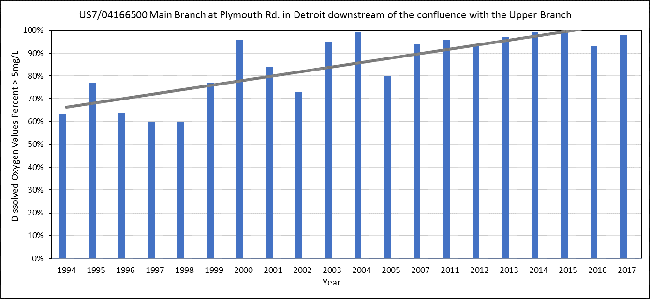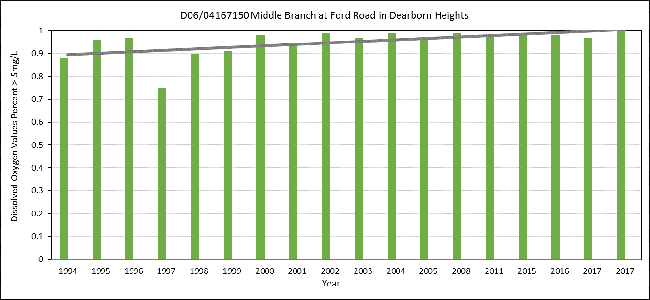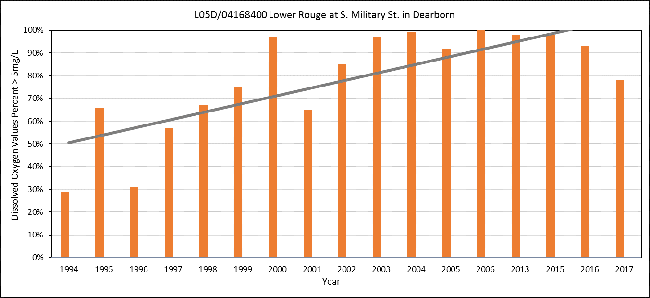Detroit River-Western Lake Erie Basin Indicator Project
Dissolved Oxygen Levels in the Rouge River
Authors
Annette DeMaria, Executive Director, Alliance of Rouge Communities, ademaria@ectinc.comNoel Mullett Jr., Technical Projects Coordinator, Wayne County Department of Public Services – Water Quality Management Division, nmullett@co.wayne.mi.us
Background
The Rouge River watershed in southeast Michigan is largely urbanized, spans approximately 438 square miles (1,210 km2), is home to over 1.5 million people in 48 communities and three counties, and is a tributary to the Detroit River. From the very beginning, the Rouge River has been recognized for its strategic location and beneficial uses. Native people settled along the shores of the river to use it as a transportation route, take advantage of the water supply, and benefit from the incredible fishing and hunting (Bean et al., 2003). In 1701, the French built their fort and established the first permanent settlement in the region. Later in the eighteenth century, gristmills would be established on main forks in the river and shipyards established on the lower river. The lower Rouge River was dredged in the early 1900s to accommodate shipbuilding and the rapidly growing automobile industry. Henry Ford consolidated automobile manufacturing operations into one geographical area to create efficiencies and synergies, turning Zug Island and the lower Rouge River into the heartland of the Industrial Revolution. The Rouge River became the recipient of waste oil and other industrial pollutants.
Mass production of automobiles and subsequent intense urbanization of the Rouge River watershed placed additional stresses on the river, including storm water runoff and other diffuse sources. Chief among these were sanitary sewer overflows and combined sewer overflows that discharged untreated sanitary waste into the river during wet weather conditions. A study of the Rouge River in the early 1970s (Jackson, 1975) reported, “approximately 40 miles of the Rouge River were characterized by very poor water quality as evidenced by a macroinvertebrate community dominated by animals tolerant of severely polluted waters. The principal contaminants at that time were raw sewage and inorganic sediment entering the river via combined and/or storm sewers.”
As industrial point sources of pollution were being addressed during the 1960s and 1970s through both federal and state regulatory initiatives, it soon became clear that more would need to be done to address nonpoint sources of pollution (pollution which cannot be traced back to a single origin or source such as storm water runoff, water runoff from urban and agricultural areas, and failed septic systems). The Rouge River was still highly polluted during the 1970s; raw sewage from combined sewer overflows and sanitary sewer overflows was being discharged, there were odor problems, and fish were dying. Urbanization of the watershed had significantly increased the impervious surfaces in the watershed resulting in significant increases in the volume and amount of energy in the runoff waters after wet weather events.
Combined sewer overflows (CSOs) and polluted storm water runoff result in many water quality problems, including extreme flow variations, streambank erosion, flooding, loss of habitat, high bacteria levels, and low dissolved oxygen. Polluted storm water runoff contains bacteria, heavy metals, nutrients, oil, and pesticides. Minimizing the impact of both combined sewer overflows and polluted storm water is critical to the restoration of the Rouge River and its impact on the Detroit River.
Dissolved oxygen is an important parameter in defining the health of aquatic ecosystems. When dissolved oxygen concentrations are below 4.0 mg/L, there are potentially adverse impacts on aquatic life. To protect aquatic life, State of Michigan water quality standards specify that dissolved oxygen must be greater than 7 mg/L at all times for streams designated as cold water fisheries and must be greater than 5 mg/L at all times for streams designated as warm water fisheries. All of the Rouge River and its tributaries are designated as warm water streams except for Johnson Creek, which is designated as a cold water fishery.
Therefore, dissolved oxygen levels in the Rouge River has been identified as a key indicator of environmental quality and a key indicator that tracks effectiveness of water pollution control programs. It should be noted that this indicator is important to both the restoration of the Rouge River and its subsequent impact on the Detroit River.
Status and Trends
Many initiatives have taken place in support of forging a holistic approach to watershed management for the Rouge River. The Rouge River Remedial Action Plan (RAP) process began in 1985 with the recognition that state government had the authority to force corrective action, but due to the diffuse nature of the problem and large expense, public awareness and local community commitment, cooperation, and involvement were essential to restoring the Rouge (Bean et al., 2003). The Rouge River Basin Committee was established to work with local governments and stakeholder groups to bring about local ownership of the RAP. All 48 communities in the watershed participated on the Rouge River Basin Committee along with other stakeholders.
The initial Rouge River RAP was completed in 1988. The RAP focused heavily on sanitary sewer overflows and combined sewer overflows because approximately 31 billion gallons of untreated combined sewage was being discharged into the Rouge River during rain events annually. It is important to note, however, that although the 1988 RAP recommendations focused on sanitary sewer capacity and CSO control, it also recognized polluted storm water from separated sewers as a significant problem across the entire watershed. In addition, it allowed for the formation of the Rouge Remedial Advisory Council (RRAC) who oversee implementation of the RAP.
Between 1992 and 2014, the Rouge River National Wet Weather Demonstration Project (Rouge Project) was managed by the Rouge Program Office with $350 million in funding from the U.S. Environmental Protection Agency (Cave, 2014) plus millions from local communities. The Rouge Project recognized that to be cost-effective, pollution problems in the river must be addressed collaboratively by all of the local governments, the counties, and the other stakeholders, and with flexibility across the regulatory programs. Decisions should be made and success evaluated based on resource results, and/or based on creating the capacity to better manage the resource, and not solely on meeting permit compliance requirements and timelines. This comprehensive watershed restoration effort dealt with the problems of CSOs, sanitary sewer overflows (SSOs), and polluted storm water runoff. Regulatory policy, programs, and financial institutional arrangements were also major accomplishments of the Rouge Project. Outcomes of the Rouge Program Office and its successor, the Alliance of Rouge Communities (ARC), include the following (Cave, 2014):
- Completion of 88 CSO/SSO projects;
- Completion of 47 stormwater control projects;
- Completion of 48 riparian corridor improvements;
- Discovery and removal of over 2,000 illicit discharges;
- Discovery and correction of almost 900 failed septic systems;
- Reconnection of 279 miles of river and tributary streams to the Great Lakes;
- Installation of 40,000 native trees, shrubs and plants resulting in numerous acres of green stormwater infrastructure;
- Engagement of 54,000 volunteers and outreach to more than 125,000 residents;
- Development of watershed-based plans to comply with current stormwater permitting requirements;
- Passage of the Watershed Alliance legislation which allowed for the establishment of the Alliance of Rouge Communities (ARC) in 2006;
- Comprehensive monitoring for the Rouge River watershed; and
- Collaboration among the state, counties, municipalities, nonprofits, researchers and residents to restore a once heavily damaged river system.
For the purposes of this indicator report, it was decided to focus on one of the best long-term indicators of environmental quality – dissolved oxygen levels at three locations in the Rouge River: Main and Upper subwatersheds in Detroit which includes drainage from 56% of the watershed, the Middle subwatershed in Dearborn Heights (24% of the watershed) and the Lower subwatershed in Dearborn (20% of the watershed). Each of these sites are located in the lower (most downstream) ends of the Rouge River. Consequently, these sites are the recipient of all the upstream impacts from human activity, and historically have been the portion of the river that has had the poorest water quality.
Figures 1-3 present the long-term trends of dissolved oxygen for three sub-watersheds of the Rouge River. The earliest dissolved oxygen data for the Main Branch from the 1973 study showed that only 24% of the values were above the State of Michigan’s water quality standard of 5 mg/L (Jackson, 1975). In the 1990s, the average percent compliance was 67%. This increased to 89% in the 2000s and 97% in the 2010s (Figure 1).

Figure 1. The percentage of dissolved oxygen measurements in Main and Upper subwatershed of the Rouge River that exceed the Michigan standard of 5 mg/L for protection of a warm water fishery. A higher percentage in recent years indicates that this subwatershed more frequently exceeds the standard and dissolved oxygen conditions are improving.
Similar improvements have been seen on the Middle Branch where 90% of the dissolved oxygen values were above the water quality standard in the 1990s. The average percent compliance jumped to 97% and 98% in the 2000s and 2010s, respectively (Figure 2).

Figure 2. The percentage of dissolved oxygen measurements in Middle subwatershed of the Rouge River that exceed the Michigan standard of 5 mg/L for protection of a warm water fishery. A higher percentage in recent years indicates that this subwatershed more frequently exceeds the standard and dissolved oxygen conditions are improving.
The story is a little different on the Lower Branch where intermittent sanitary sewer problems have resulted in the most recent dissolved oxygen values to be lower than in previous years. On the Lower Branch, 54% of the values were below the water quality standard in the 1990s. The 2000s saw a dramatic increase with 91% of the values above the standard. However, unlike the other subwatersheds, the average percent compliance was only 92% in the 2010s (Figure 3). This is largely due to the low concentrations found in 2017 when sewage was unknowingly being discharged to the river at two different locations. These discharges occurred because of: 1) mechanical failure on combined sewer lift station which allowed sewage to drain down the bank of the river; and 2) blockage of a sanitary sewer which allowed sewage to discharge to the river via a high-level overflow connection to a storm sewer. Both issues were subsequently corrected in September 2017.

Figure 3. The percentage of dissolved oxygen measurements in Lower subwatershed of the Rouge River that exceed the Michigan standard of 5 mg/L for protection of a warm water fishery. A lower percentage in 2017 indicates that this subwatershed more frequently violated the standard and that dissolved oxygen conditions need to be monitored to ensure the recovery of the river.
Despite the challenges in the Lower Branch, the dissolved oxygen trends document that substantial improvements are occurring in most of the watershed as a result of the river restoration measures.
It is recognized that many indicators are needed to fully assess the health of the Rouge River watershed. In 2013, the RRAC updated the Rouge River Report Card which summarized the progress of the Rouge River Remedial Action Plan. The 2013 Report Card indicates that the footprint of nine of the ten beneficial use impairments is shrinking (RRAC, 2013). This means that the river is responding to restoration efforts beyond the improvements in dissolved oxygen conditions. This is demonstrated by fewer algal blooms, fewer restrictions on fish consumption, healthier fish communities, improved fish and wildlife populations and fewer aesthetics concerns. The only indicator that did not improve in 2013 was sediment contamination. However, the U.S. EPA along with private partners are currently in the process of dredging contaminated sediments from the Rouge River Old Channel around Zug Island. Likewise, despite vast reductions in E. coli concentrations, bacterial contamination persists in the river system as demonstrated by a lack of compliance with Michigan’s full body contact standards for recreational waters (ECT, 2018).
Management Next Steps
Key management actions for the Rouge River watershed include:
- Continue to implement long term control plans to address CSOs;
- Continue sanitary sewer capacity improvements;
- Sustain the watershed-wide implementation of public education, illicit discharge elimination and water quality monitoring programs initiated by the Rouge Project and continued under the ARC and FOTR;
- Promote the use of green stormwater infrastructure to reduce peak flows in the river;
- Promote the economic importance of the region’s water resources and green spaces to encourage adequate public investment in continued watershed restoration and protection efforts; and
- Ensure sufficient collaboration among the watershed communities and counties, nonprofits, and the State Legislature to secure adequate funding to continue cost-effective restoration efforts (this includes establishment of stormwater utilities to generate sustainable funding for stormwater management).
Research/Monitoring Needs
Monitoring is essential for proper watershed management. The level of water quality monitoring in the Rouge has significantly decreased in the absence of the Rouge Project. Priority must be given by State and Federal agencies to ensuring sufficient monitoring to be able to adequately evaluate effectiveness of programs and to make midcourse corrections. This includes the monitoring of water quality, flow, benthic macroinvertebrates, and other aquatic species. Further research on rapid microbial source tracking techniques could be helpful in tracking down human and animal sources of bacteria that are leading to water quality impairments.
References
- Bean, C.J., J.H. Hartig, and N. Mullett Jr. 2003. Watershed planning and management: The Rouge River experience. In Honoring Our Detroit River: Caring for Our Home, ed. John H. Hartig, pp. 185-198. Bloomfield Hills, MI: Cranbrook Institute of Science.
- Cave, K. 2014. Rouge River Restoration Summary – Wayne County Rouge River National Wet Weather Demonstration Project 1992-2014. Wayne County Department of Environment. Detroit, Michigan, USA.
- Environmental Consulting & Technology, Inc. 2017. Rouge River Ecosystem Monitoring and Assessment Report. Canton, Michigan, USA.
- Jackson, G. 1975. A biological investigation of the Rouge River, Wayne and Oakland counties, May 17-October 19, 1973. Department of Natural Resources. Lansing, Michigan, USA.
- Rouge River Advisory Council. 2013. Rouge River Watershed Great Lakes Area of Concern Beneficial Use Impairment 2013 Report Card. Canton, Michigan, USA.